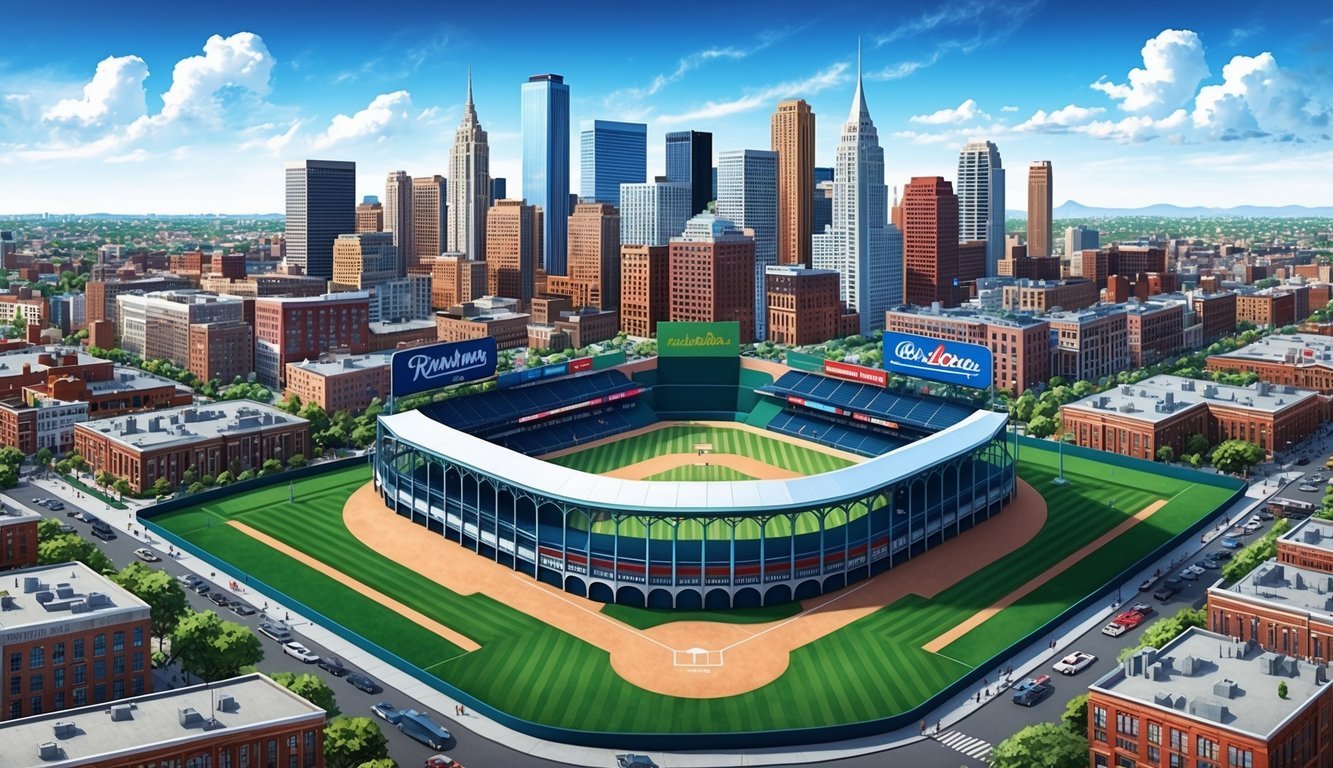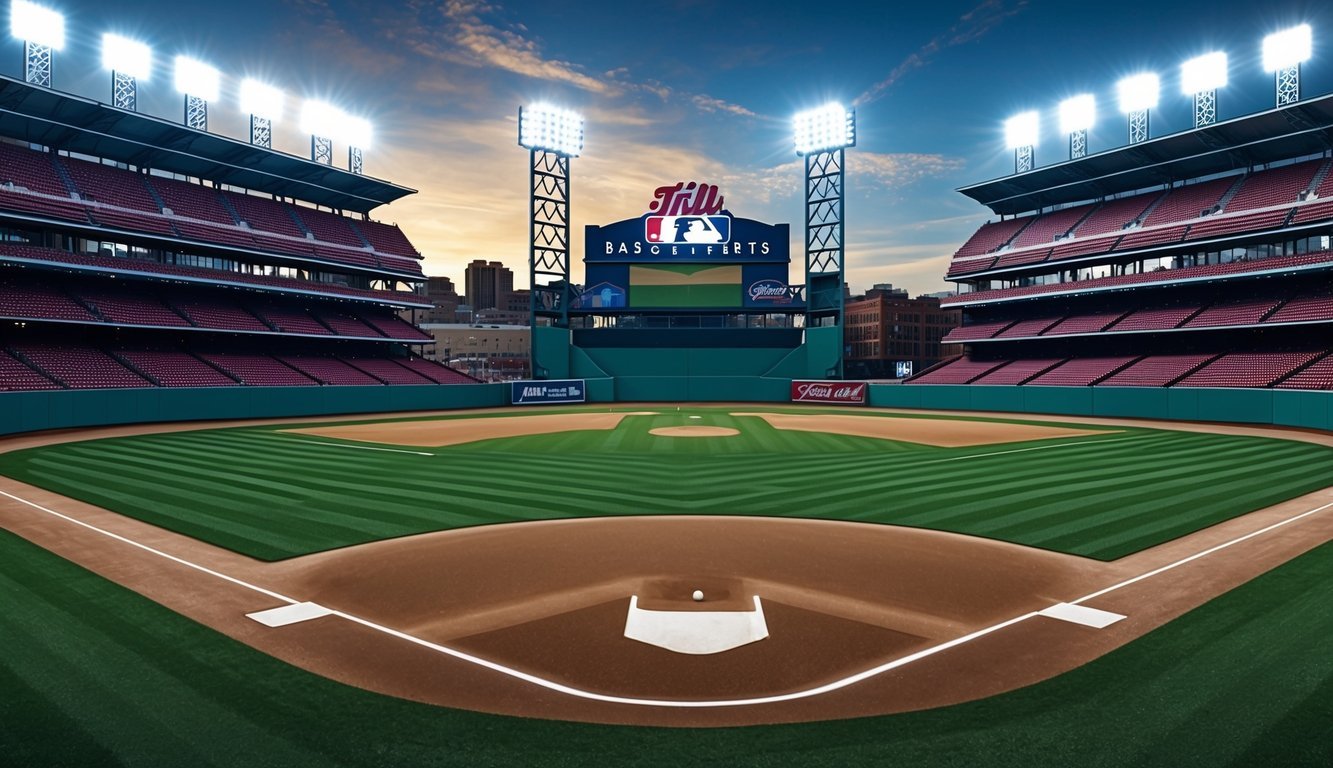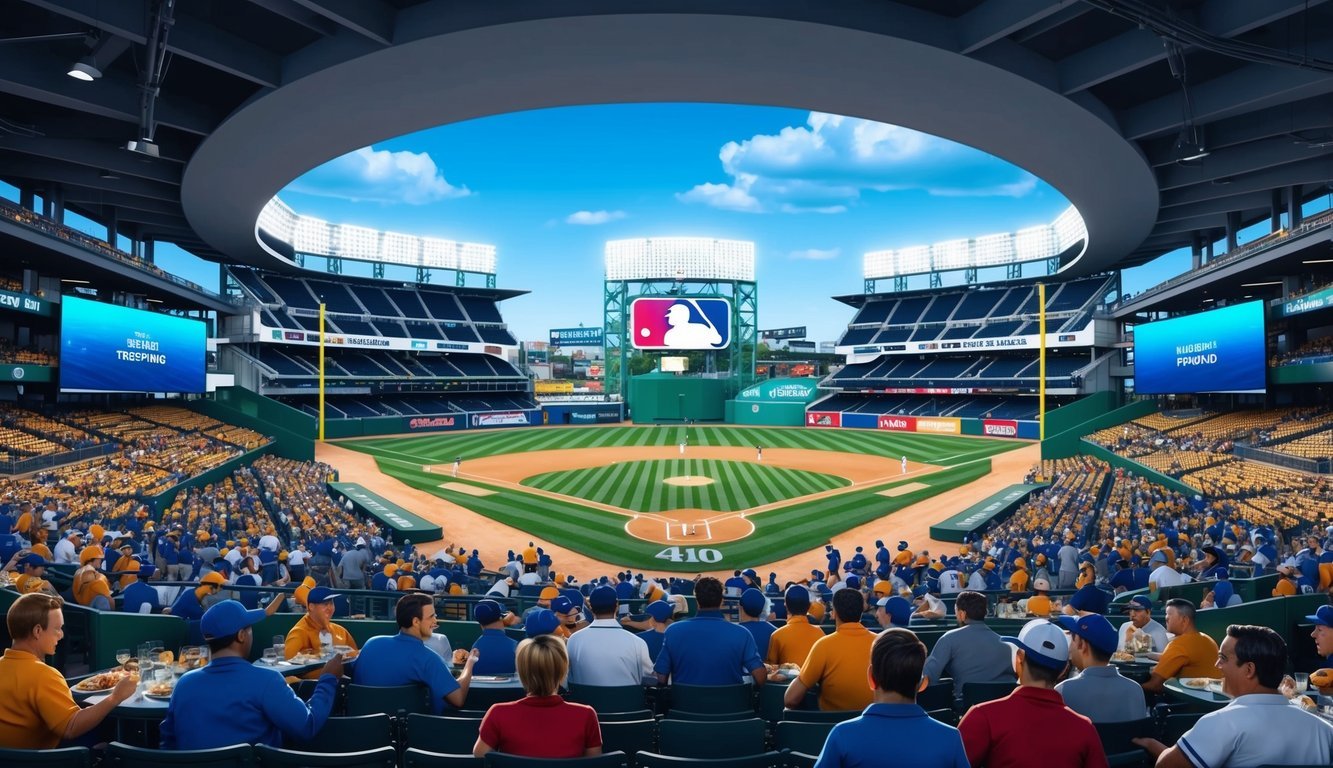Baseball stadiums are more than just venues for America’s favorite pastime.
They’re iconic landmarks that capture the essence of the sport and its rich history.
From Fenway Park’s legendary Green Monster to the breathtaking views at Safeco Field, each ballpark has its own unique charm and character.
Major League Baseball boasts some of the most beloved and influential stadiums in sports history. Oriole Park at Camden Yards revolutionized ballpark design when it opened in 1992, sparking a new era of retro-classic stadiums that blend modern amenities with nostalgic aesthetics.
These iconic fields have witnessed countless unforgettable moments, from record-breaking home runs to nail-biting World Series games.
Visiting these hallowed grounds is a must for any true baseball fan.
Whether it’s soaking in the old-school atmosphere of Wrigley Field or marveling at the cutting-edge technology of newer stadiums, each ballpark offers a one-of-a-kind experience.
The sights, sounds, and smells of the game come alive in these cherished venues, creating memories that last a lifetime.
Legendary Ballparks and Their Histories
Baseball’s most iconic stadiums have witnessed countless historic moments and shaped the sport’s rich legacy.
These hallowed grounds have become integral parts of their cities’ identities and continue to captivate fans decades after their construction.
Fenway Park: A Boston Gem
Fenway Park, home of the Boston Red Sox since 1912, stands as a testament to baseball’s enduring charm.
Its distinctive green walls and manual scoreboard transport fans back in time.
The famous 37-foot-tall left field wall, known as the “Green Monster,” has challenged hitters for generations.
Fenway’s quirky dimensions, including the triangle in center field, add unique character to the ballpark.
Despite numerous renovations over the years, the stadium has maintained its classic feel. Red Sox legends like Ted Williams and Carl Yastrzemski created lasting memories on this historic field.
The intimate seating brings fans close to the action, fostering a special connection between the team and its supporters.
Fenway Park remains a beloved destination for baseball enthusiasts worldwide.
Wrigley Field: The Heart of Chicago
Wrigley Field, opened in 1914, is the cherished home of the Chicago Cubs.
Its ivy-covered outfield walls and hand-operated scoreboard are iconic features that have stood the test of time.
The famous red marquee at the main entrance welcomes fans to this baseball sanctuary.
The ballpark’s location in the Wrigleyville neighborhood creates a festive atmosphere on game days.
Rooftop seating on nearby buildings offers a unique viewing experience.
Wrigley’s day games are a beloved tradition, as it was the last major league park to install lights in 1988.
Recent renovations have modernized amenities while preserving the stadium’s classic charm.
The bleachers remain a popular spot for die-hard Cubs fans.
Wrigley Field continues to be a pilgrimage site for baseball lovers from around the world.
Yankee Stadium: The Pride of New York
The original Yankee Stadium, known as “The House That Ruth Built,” opened in 1923.
It became the stage for many of baseball’s greatest moments and players.
The New York Yankees’ 26 World Series championships cemented its status as hallowed ground.
In 2009, a new Yankee Stadium debuted across the street from the original site.
The modern ballpark incorporates elements from its predecessor, including the iconic frieze along the roof.
Monument Park, honoring Yankee legends, remains a focal point for fans.
The new stadium blends state-of-the-art facilities with nods to the team’s storied past.
While some traditionalists miss the old park, the current Yankee Stadium continues to create its own legacy as home to one of baseball’s most successful franchises.
Architectural Marvels and Their Features
Baseball stadiums combine innovative design with nods to tradition.
Modern venues integrate cutting-edge amenities while preserving the sport’s timeless charm.
Let’s explore three standout parks that exemplify architectural excellence in America’s pastime.
PNC Park: Blending Modernity and Intimacy
PNC Park, home of the Pittsburgh Pirates, opened in 2001 and quickly became a fan favorite.
Its intimate seating bowl brings spectators close to the action.
The stadium’s limestone facade and steel truss work pay homage to Pittsburgh’s industrial heritage.
Key features include:
- Stunning views of the downtown skyline and Roberto Clemente Bridge
- Two-tier seating design for improved sightlines
- Wide concourses with local food options
The park’s asymmetrical outfield adds character, with the right field wall standing just 21 feet high.
Oracle Park: Scenic Splendor
The San Francisco Giants play in one of baseball’s most picturesque settings.
Oracle Park, built in 2000, offers breathtaking bay views.
Its location allows for unique features that set it apart from other stadiums.
Highlights include:
- McCovey Cove, where kayakers await home run balls
- The iconic Coca-Cola bottle slide and giant baseball glove
- Edible garden behind center field
The park’s brick exterior blends seamlessly with the surrounding warehouse district.
Inside, fans enjoy modern amenities while soaking in the maritime atmosphere.
Coors Field: Altitude with Attitude
Home to the Colorado Rockies, Coors Field opened in 1995 and embraces its high-altitude setting.
The stadium’s design incorporates elements that reflect Colorado’s natural beauty and baseball heritage.
Notable features:
- Purple row of seats marking exactly one mile above sea level
- Expansive outfield to counteract thin air effects on hitting
- Rocky Mountain-inspired fountains and landscaping
Coors Field’s architects used hand-laid brick and forest green steel to create a classic ballpark feel.
The stadium’s huge outfield and thin air make it a hitter’s paradise, adding excitement to every game.
Cultural Impact of Stadiums on Cities

Baseball stadiums have become integral parts of urban landscapes, shaping city identities and fostering community pride.
These iconic structures serve as gathering places, economic drivers, and cultural landmarks.
As urban centers continue to develop, baseball stadiums reflect the changing dynamics of their surroundings, often integrating modern amenities while honoring the traditions of the game.
They not only host thrilling matches but also serve as venues for concerts, festivals, and community events, further embedding themselves into the fabric of city life.
This evolution mirrors baseball’s evolution in America, showcasing how the sport adapts to contemporary societal trends while retaining its historical significance.
Camden Yards and Baltimore’s Revival
Camden Yards transformed Baltimore’s downtown when it opened in 1992.
The stadium’s retro design sparked a renaissance in baseball architecture and urban planning.
It attracted new businesses and restaurants to the area, revitalizing a once-neglected part of the city.
The Baltimore Orioles‘ home field quickly became a tourist destination, drawing visitors from across the country.
Its success inspired other cities to build similar ballparks in urban centers.
Camden Yards also preserves a piece of Baltimore’s industrial heritage.
The B&O Warehouse, now part of the stadium complex, stands as a reminder of the city’s railroad history.
Dodger Stadium: Los Angeles’ Diamond in the Hills
Nestled in Chavez Ravine, Dodger Stadium has been a Los Angeles landmark since 1962.
The stadium offers breathtaking views of the city skyline and nearby mountains, making it a quintessential LA experience.
The Dodgers’ move from Brooklyn to Los Angeles in 1958 helped establish the city as a major league town.
Dodger Stadium became a symbol of the city’s growth and ambition.
Celebrity sightings at games add to the stadium’s Hollywood allure.
The famous Dodger Dog and other local food offerings celebrate the city’s diverse culinary scene.
Petco Park: San Diego’s Urban Oasis
Petco Park, home of the San Diego Padres, opened in 2004 and quickly became a catalyst for downtown redevelopment.
The stadium’s design incorporates the historic Western Metal Supply Co. building, blending old and new architecture.
The park’s location near the Gaslamp Quarter encourages fans to explore downtown before and after games.
Its open concourses and park areas provide public spaces for community events year-round.
Petco Park’s innovative features, like the grassy “Park at the Park” beyond center field, reflect San Diego’s laid-back, outdoor lifestyle.
The stadium has become a beloved gathering spot for locals and tourists alike.
Stadiums as Pillars of Team Identity

Baseball stadiums serve as more than just venues for games.
They embody the spirit of their teams and cities, creating lasting connections with fans.
Progressive Field: Home of the Guardians
Progressive Field in Cleveland stands as a testament to the city’s baseball legacy.
Opened in 1994, it offers stunning views of the downtown skyline.
The stadium’s design incorporates local architectural elements, like the distinctive toothbrush-style light towers.
Fans love the intimate seating and great sightlines.
The “Corner Bar” in right field is a popular gathering spot.
Kids enjoy the “Kids Clubhouse” play area.
Team history is celebrated throughout.
The Heritage Park area honors Cleveland baseball legends.
On game days, the smell of hot dogs and the sound of drums fill the air, creating a uniquely Cleveland experience.
Busch Stadium: Cardinal Nation’s Pride
Busch Stadium in St. Louis is the heart of Cardinal Nation.
Opened in 2006, it offers breathtaking views of the Gateway Arch.
The red brick exterior blends seamlessly with the surrounding neighborhood.
Inside, fans find nods to Cardinals history everywhere.
Statues of team legends greet visitors outside.
The Cardinals Hall of Fame and Museum sits adjacent to the park.
The stadium’s open concourses allow fans to stay connected to the action.
Busch Stadium’s atmosphere is electric, especially during playoff games.
The sea of red-clad fans creates an intimidating environment for opposing teams.
Citizens Bank Park: Where Phillies Fans Unite
Citizens Bank Park in Philadelphia opened in 2004, ushering in a new era for Phillies baseball.
The stadium’s red brick and steel design pays homage to classic ballparks while offering modern amenities.
Fans rave about the food options, including Philly cheesesteaks and crab fries.
Ashburn Alley, behind center field, is a popular pre-game hangout spot.
It features a Phillies Wall of Fame and statues of team greats.
The stadium’s intimate feel puts fans close to the action.
The Liberty Bell replica lights up and rings after Phillies home runs.
On summer nights, the energy in Citizens Bank Park is palpable as fans rally behind their team.
The Evolution of Stadium Amenities and Fan Experience

Modern baseball stadiums prioritize comfort, technology, and entertainment to create unforgettable experiences for fans.
These venues blend cutting-edge amenities with nods to team history and local culture.
Target Field: Minnesota Twins’ Modern Marvel
Target Field, home of the Minnesota Twins, opened in 2010 and set a new standard for fan-friendly ballparks.
The stadium features wide concourses with panoramic views of downtown Minneapolis.
Local food vendors offer diverse dining options, including the famous “Juicy Lucy” burger.
Tech-savvy fans appreciate the high-speed Wi-Fi and mobile app for in-seat food ordering.
The stadium’s design incorporates Minnesota limestone and native plants, connecting it to the local landscape.
Family-friendly areas include a playground and interactive games.
On hot days, misting stations keep fans cool.
The intimate seating bowl ensures great views from every angle, bringing spectators closer to the action.
T-Mobile Park: Seattle Mariners’ Tech-Forward Haven
T-Mobile Park, where the Seattle Mariners play, embraces technology to enhance the fan experience.
The retractable roof ensures comfortable viewing regardless of weather conditions.
High-definition video boards display real-time stats and replays.
The park’s mobile app offers augmented reality features, allowing fans to explore player stats and team history.
Unique food options include fresh seafood and local craft beers.
The “Hit It Here Café” provides diners with a prime view of the game.
Kids enjoy the expansive children’s play area and interactive baseball-themed games.
Art installations throughout the concourses celebrate Pacific Northwest culture and Mariners history.
The stadium’s location offers stunning views of Puget Sound and the Seattle skyline.
Truist Park: The Braves’ New Southern Home
Truist Park opened in 2017 for the Atlanta Braves.
The stadium anchors a year-round entertainment district.
The stadium blends modern amenities with Southern charm.
A massive HD video board keeps fans informed and entertained throughout the game.
The park features a variety of seating options, from traditional bleachers to premium clubs.
Local eateries serve up Southern favorites alongside classic ballpark fare.
The Chop House restaurant offers field-level dining with a unique perspective on the game.
Outside the stadium, The Battery Atlanta buzzes with shops, restaurants, and live music venues.
Inside, kids enjoy the Hope & Will’s Sandlot play area.
The Monument Garden celebrates Braves history with interactive displays and artifacts.
